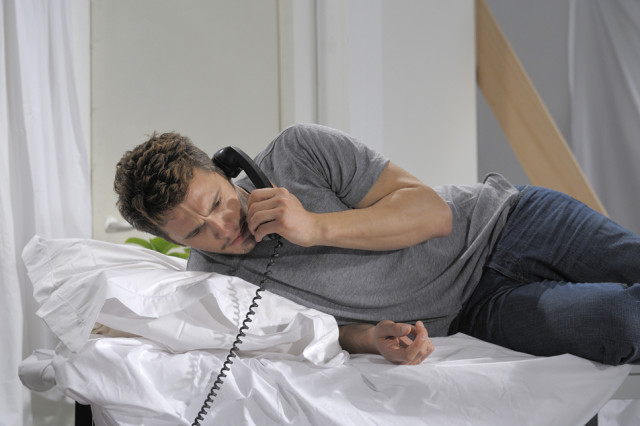Erased James Franco

James Franco answers another phone call in Erased James Franco.
There’s a phrase that popular TV chef Gordon Ramsay always uses on the British version of his show Kitchen Nightmares. He walks into some inn with a stone facade with a name like the Pusslewick Arms (you see, the title always has to have the suffix "-wick" and end in Arms) and sees a single chef working in a grease-stained kitchen, dropping individual serving bags of lamb in a boiling pot and plating it by scooping the skin off the top of some four-day-old gravy. Ramsay asks how much this restaurateur is charging for this dish of plastic lamb and days-old gravy. The response usually is a ridiculous amount, around £15 ($30 or so), to which Ramsay wipes his nose with his forearm, furrows his brow and incredulously asks this question: "Are you taking the piss?"
That was my response to Erased James Franco.
Honestly, I think Franco and director Carter’s (no other name; just Carter) main endeavor was to take the piss during this movie, much in the same way Rauschenberg did with his "Erased de Kooning." Of course, a major difference between the works is Rauschenberg did his erasing on a work from arguably the greatest living artist at the time, while Carter works with James Franco, whose most critically acclaimed individual work was in an action pot comedy. It’s not that Franco is a bad actor (he’s actually quite good), it’s just that erasing him doesn’t quite have the same effect. If this work were done with, say, Daniel Day-Lewis, then you’d see something as off-putting and magnetic as Carter wanted this to be.
The movie itself has no narrative structure. It simply is Franco with a series of props: a red leather upholstered chair, a desk, a brass statue of a head (always turned away from the camera), balloons, a fern, a Franco-created painting, glasses of water, several telephones, and a prosthetic leg. Much of it consists of Franco answering the phones, listening to some barely audible lines, giving a grunt or sigh as a response, and then hanging up. As a seminar in acting through grunts, sighs, and facial expressions, it succeeded.
Then he would take this seminar to other daily activities such as drinking water. He would pick up a glass with a whole hand, then with only a few fingers, and then saddle-horn style spilling the water all over his face in the process. He would then show us the many ways one can eat crackers. I wondered to myself if he would also act out going to the bathroom. The next scene, he was sitting in the chair, looking at the camera, squirming, grunting, and breathing hard for a bit, and then let out a sigh of relief. My question was answered.
This work was an endurance test for the audience. More than 20 people walked out of the screening I attended, and you could see why. The four-minute sequence where Franco rotates a chair 360 degrees was like the Paul Rudd clean-up scene from Wet Hot American Summer but not played for laughs. The sequence where the camera follows Franco as he walks down a hall and through a doorway, then abruptly stops at a wall is repeated nine times. They were daring us to leave, it seemed. They acknowledged that they were making us watch a guy just walk into a wall over and over again. I stayed due to simple morbid curiosity and the hope that they would give us shirts on our way out of the theater with "I sat through Erased James Franco and all I got was this stupid shirt" written across the front.
Staying would pay off by the end, though. As Franco acted out parts as Rock Hudson and Julianne Moore from other movies, moving through the monologues and wrenching emotion from every word, it was a disconcerting effect—someone who has been so flat and inactive for the past hour suddenly feels and there’s no context as to why. The end is a culmination, as Franco finally stops giving the camera furtive glances with grunts, and he looks directly through the camera out at the audience and repeats the words, "I love you."
At its most successful, Erased James Franco mined emotion from little to no context at all. At its worst, it was a guy sitting around showing us how to eat crackers.
Which brings me back to Chef Ramsay’s question. Were Franco and Carter taking the piss? I certainly hope they were. If the film was meant to mess with the audience and their expectations, forcing them to squirm in their seats as Franco holds a flashlight in his mouth as he writes on notebook paper for five minutes, and ask them how much nothing they are willing to sit through, it wildly succeeded. If they were actually serious about that, then Erased James Franco was one of the most self-indulgent works I’ve ever seen.
